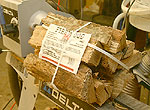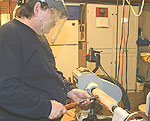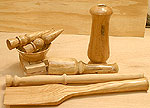This is a Veteran Owned site
 |
This $4 bundle of firewood became two fun and educational days of turning. Click image to enlarge |
Turning Firewood
Cheap fun at the lathe
Text & Photos by Tom Hintz
Woodturner's often describe a project gone wrong as "making firewood." That made me wonder if the reverse could be true; could we turn firewood into projects? Recently, when my scrap bin ran out of turnable pieces, I came across a pile of hardwood firewood in small bundles at a local gas station and decided to try it.
The bundle in the photos cost $4 and was chosen at random from the huge pile. I suspect a better deal could be found but with the price of gas, I was not going to drive around looking.
Some bundles in the pile looked better than the one I grabbed but many looked equal to or worse in terms of the visible contents. For our purposes here, I wanted to lean towards the worse case scenario to see what I could turn from one bundle.
The label indicates the bundle consists of 100% southern hardwood but said nothing about moisture content. Since all of the surfaces of this split wood appeared to be weathered, I was hopeful the wood was reasonably dry. It certainly does not feel wet, which is a decided advantage over some of the "found wood" I have turned.
All but two pieces in the bundle were red oak. One appears to be a maple branch and the other maple in the early stages of spalting.
Sorting & Trimming
 |
Trimming the pieces with a project in mind was difficult at times. This piece would become a carvers mallet. Click image to enlarge |
I began by sorting the pieces according to size and condition. While I expected deep cracks, few were discovered. There were a few surface cracks and some loose edges that were pulled off before turning. However, none of the visible defects had a major impact on the useable portion of the piece. I also looked each piece over for signs of metal but found none.
Next, the obvious waste was trimmed away and the ends cut relatively square on the band saw. Trimming the ends made putting them between centers easier and safer, but also got rid of irregular or "punky" (soft) portions.
Two pieces proved to be too small for turning between centers and were cut into pen blanks. A few of the cut offs from trimming were also reduced to pen blanks.
Trimming the pieces turned out to be one of the more challenging parts of turning fire wood. "Reading" the pieces of wood to recognize potential projects within it was a learning process. Stopping frequently during rounding also helps seeing where the grain and defects in the wood are leading you in terms of what can be turned from it.
Turning
 |
Turning firewood is just as dangerous as any other kind of wood. Wearing a good face shield and being safe in everything you do at the lathe is mandatory. Click image to enlarge |
Warning: Turning some firewood pieces can be challenging. Being able to "read the ghost," the blurred image of the high and low spots as the piece turns, is a definite plus. If you are not familiar with turning uneven objects, this can be a good time to learn, but go slow and be safe! Caution and a good face shield are just the start. You have to be very careful of hand position, lathe speed, how the tool is introduced to the wood and the condition of the wood itself. A change in sound could mean a piece is splitting away. Stopping frequently and whenever an odd sound is heard, is a good safety practice.
Always trust your sense of danger. If something seems dangerous, it just might be. Stop and think about how to be safer. Sometimes, throwing a piece of wood away is the safest thing to do.
 |
This twisted flat piece (Top) was almost cut into pen blanks. After a little thought, a pizza paddle (Bottom) became the goal. Click images to enlarge |
Once the wood is nearly rounded, turning firewood becomes just like turning any other kind of stock. The size dictates what can be carved from it. When all else fails, turning a few handles in various sizes for future jigs, fixtures or mallets is always useful.
One of the most interesting parts of woodturning is how the wood itself can suggest a shape or project. In the case of firewood, the way a piece was split or cut can limit what can be made from it. Keep your imagination working!
A flat, wide piece in the bundle looked like it might be good for small handles or pen blanks only. After looking at how the grain flowed through it and a curve in the middle, I thought about a pizza paddle. The piece in the photo is the result of using the flow of the grain and shape of the piece to help design the project. The bandsaw was used to finish shaping the flat paddle portion but the entire handle and outer edges of the paddle were done on the lathe.
Because this wood is so cheap, I found this a good time to try new techniques or projects that seemed too risky for expensive or rare material. Starting with such irregularly shaped wood also forced me to practice cuts and tool positions not often used with more common turning blanks.
In the End
What began as a $4 bundle of wood became two good days of enjoyable and educational turning that yielded the objects in the photo. One piece was discarded because it was rotten near the middle and just was not safe to turn. A smaller piece was trashed by an overconfidence-induced catch that cracked it fatally.
One larger piece proved to be rather wet inside but I turned it into a small carving mallet anyway. Immediate sanding, finishing and buffing on a coat of Carnauba wax seem to have prevented cracking or obvious distortions.
In addition to having a few more things to give away (or sell if you like) I had a good time at the lathe on very little money and came away knowing a little more about turning than when I began.
Do you have a comment about this story? – Email Me!
All written, photographic and drawn materials are property of and copyright by NewWoodworker.com LLC 2000-2019. Materials may not be used in any way without the written permission of the owner.

